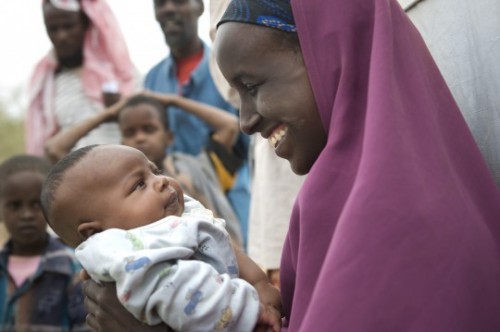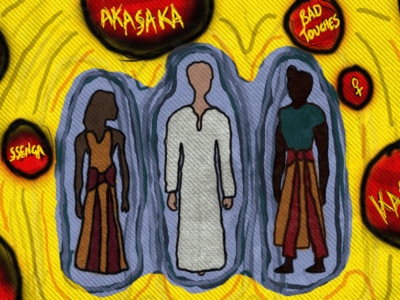This post is part of our special coverage on Refugees.
An aerial photograph, posted on Oxfam International's Flickr page, of the world's largest refugee camp in Dadaab, Kenya, illustrates how extensive the problem of displacement can be. The camp is home to 450,000 refugees, most of which have fled drought and a civil war in Somalia waged since 1991. A further 1,500 arrive every day.
Hoping to find respite from conflict, famine and natural disaster, 75 percent of all refugees are believed to reside in countries neighboring their own, sometimes creating a humanitarian crisis that can stretch the resources of national governments and international organizations.
Not only is the international relief organization using the Internet to spread information and images about the situation in the camp on Twitter and Flickr, but it has also posted a video journal by actress and Oxfam Ambassador Scarlett Johansson on YouTube:
Of course, so serious is the situation in Dadaab that Oxfam is not the only international organization working in the camp and one aid worker, Amy Burke, is providing regular updates on the Lutheran World Relief blog:
The worst drought in 60 years has left millions of people at the brink of starvation. Their crops have died along with their livestock. Without any means to feed themselves, tens of thousands have flocked here to Dadaab, Kenya — home to the world’s largest refugee camp.
With the media now reporting that cholera is once again spreading in the camp, Burke highlighted the danger at the beginning of November:
The rains are coming.
This may sound like a beautiful sentiment for the East African refugees who have suffered from severe droughts in the Horn of Africa during this past year. While the rains bring new life and revival, they also bring many waterborne diseases. It’s estimated that about 75,000 people in Dadaab alone could fall ill due to the spread of disease.
Indeed, accounts such as Burke's are crucial in getting information out from the camp once media attention has died down:
The headlines have ceased. The struggle is silent. Only the crisis remains.
While the drought in East Africa and the mass relocation of hundreds of thousands of people to the overcrowded refugee camps in Dadaab have stopped making headlines, the nature of the situation is still incredibly dire.
Refugees are real people, not just an overwhelming statistic. Each one of the 400,000 residing in Dadaab is a real person with a real life and real needs–but often, we push them and their plight to the back of our minds believing that there is nothing we can do.
It's perhaps for that reason that Burke has also painted a more human picture of life in the camp, highlighting personal stories that many outside of Dadaab would consider ones of bravery and courage:
Ambiya lived in Somalia with her daughter, mother, and grandmother. Due to an increasing drought situation and famine spreading throughout her country, it was time to flee to a safer location. She was in no state to leave however; and after eating little to nothing for 18 days, 20-year-old Ambiya gave birth to her son Hamza.
[…] Being a new mother isn’t easy; making sure your baby is healthy, safe and that his or her needs are met is a full time responsibility. While this is stressful enough, imagine leaving your home country, walking by foot for at least a week, losing every one of your material possessions to a drought, and arriving to a new place in order to start a new life with nothing but the clothes on your back.
Without delay, the day after she gave birth, Ambiya left with her newborn, daughter, mother and grandmother on a long trek from Somalia to Kenya. […] Most people’s only goal is to survive the journey — a lofty, and in many cases, unobtainable hope. For Ambiya, her goal was to get her whole family to Dadaab alive, especially her one-day-old newborn.
[…] The problem with distancing ourselves from her story and her feat is that we tend to fictionalize her. Ambiya is a real person who persevered during what was probably the most difficult experience of her life. She represents pure strength. Her action was real and it was emblematic of how the love and strength of a mother extends beyond logic and self-preservation far into love and self-sacrifice.
Burke also posts accounts of how refugees are creating communities and attempting to make a living:
Refugees once artisans, tailors, farmers, etc. have found ways to utilize their skills and exchange resources within their new communities in Dadaab.
While aid remains a necessary and life-sustaining component to those living in Dadaab, markets have begun to spring up helping the refugees find ways to meet some of their own needs.
Trade is abundant while those lucky people who still own livestock sell milk and cheese, tailors with a few bits of extra fabric make garments, basket weavers once again take to their craft, and whoever has the means to buy seeds, grows a garden and sells the vegetables, etc.
The markets have helped improve individual livelihoods, built a larger community, and provided easier access to some resources. With the recent influx of people and new goods to trade, the markets are flourishing — creating within Dadaab a small market economy of its own.
Reuters Multimedia Producer Natasha Elkington has also put together a video of life in the camp with the same aim:
I wanted to see if I could tell their story through a different lens, showing their daily lives instead of just glaring down at their ribbed bodies and swollen eyes.
[…]
[…] Many of Dadaab’s children are dying. And then there are others who, despite living in the world’s oldest refugee camp, embrace their childhood; they play, go to school, care for their siblings and collect water for their families. I wanted to incorporate all of these aspects of life for Dadaab’s children into this project.
http://www.youtube.com/watch?feature=player_embedded&v=GVUJpUMwDro
According to the United Nations High Commissioner for Refugees (UNHCR), the number of refugees has now reached approximately 43.7 million people worldwide, the highest in 15 years. The number of Internally Displaced People (IDPs) has also risen and stood at 27.5 million at the end of 2010.
This post is part of our special coverage on Refugees.











3 comments
Update: The International Rescue Committee have a post on keeping cholera in check in Dadaab:
http://www.rescue.org/blog/keeping-cholera-check-world%E2%80%99s-largest-refugee-camp